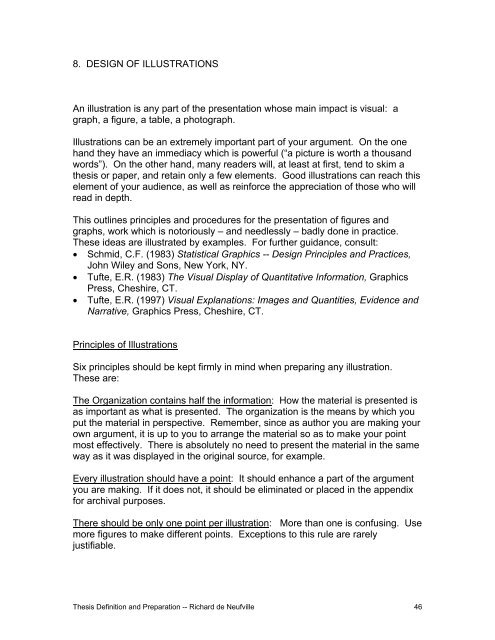Richard de Neufville's TPP SM Thesis Manual - Title Page - MIT
Richard de Neufville's TPP SM Thesis Manual - Title Page - MIT
Richard de Neufville's TPP SM Thesis Manual - Title Page - MIT
- No tags were found...
You also want an ePaper? Increase the reach of your titles
YUMPU automatically turns print PDFs into web optimized ePapers that Google loves.
8. DESIGN OF ILLUSTRATIONSAn illustration is any part of the presentation whose main impact is visual: agraph, a figure, a table, a photograph.Illustrations can be an extremely important part of your argument. On the onehand they have an immediacy which is powerful (“a picture is worth a thousandwords”). On the other hand, many rea<strong>de</strong>rs will, at least at first, tend to skim athesis or paper, and retain only a few elements. Good illustrations can reach thiselement of your audience, as well as reinforce the appreciation of those who willread in <strong>de</strong>pth.This outlines principles and procedures for the presentation of figures andgraphs, work which is notoriously – and needlessly – badly done in practice.These i<strong>de</strong>as are illustrated by examples. For further guidance, consult:• Schmid, C.F. (1983) Statistical Graphics -- Design Principles and Practices,John Wiley and Sons, New York, NY.• Tufte, E.R. (1983) The Visual Display of Quantitative Information, GraphicsPress, Cheshire, CT.• Tufte, E.R. (1997) Visual Explanations: Images and Quantities, Evi<strong>de</strong>nce andNarrative, Graphics Press, Cheshire, CT.Principles of IllustrationsSix principles should be kept firmly in mind when preparing any illustration.These are:The Organization contains half the information: How the material is presented isas important as what is presented. The organization is the means by which youput the material in perspective. Remember, since as author you are making yourown argument, it is up to you to arrange the material so as to make your pointmost effectively. There is absolutely no need to present the material in the sameway as it was displayed in the original source, for example.Every illustration should have a point: It should enhance a part of the argumentyou are making. If it does not, it should be eliminated or placed in the appendixfor archival purposes.There should be only one point per illustration: More than one is confusing. Usemore figures to make different points. Exceptions to this rule are rarelyjustifiable.<strong>Thesis</strong> Definition and Preparation -- <strong>Richard</strong> <strong>de</strong> Neufville 46
















